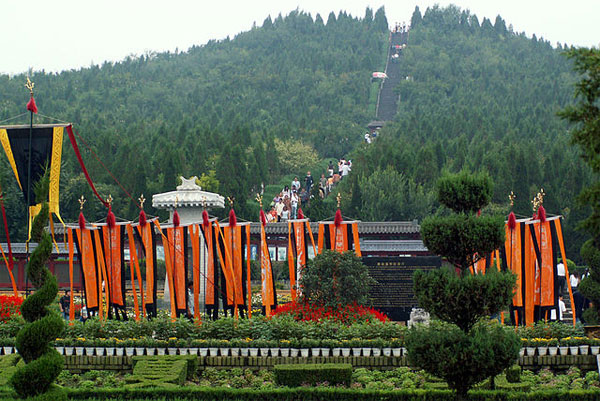The mystery of the tomb Qin Shihuang
The tomb of Qin Shihuang was discovered more than 40 years ago but scientists and archaeologists still discovered the secrets hidden inside the tomb of the first emperor of China. Why so?
The tomb of Qin Shihuang is considered one of the greatest archaeological discoveries of all time. The mysteries of the tomb area are sealed and buried beneath the vegetation layer over thousands of years.
Qin Shi Huang mobilized about 700,000 people across the country to build the tomb in 38 years. The burial site was only completed a few years after his death. According to Historian Tu Ma Thien, the tomb area contains many palaces and artifacts, precious jewels. The two Changjiang and Yellow River rivers flowing into the big sea are also simulated in the grave using mercury.

Qin Shihuang's tomb is covered by vegetation that looks like a hill.(Photo: Wikimedia)
The mausoleum of the tomb depicts rivers and land features, the upper part is a decoration of the constellations in the sky. This idea is supposed to keep Qin Shihuang going on to rule the kingdom even after coming to the afterlife. In order to protect the tomb, the emperor's craftsman creates traps that can shoot arrows at anyone who enters.
When Qin Shihuang's funeral ended, the tomb in the tomb was blocked, the outer gate lowered to lock all the craftsmen inside. This is to ensure that the mechanical trap as well as the treasure will not be revealed to the outside. Trees were planted above the tomb, making it look like a hill.
Most builders and people involved in the design of the project, among more than 70,000 people, have been killed.
Documents related to Qin Shihuang's resting place existed for nearly a century after the emperor's death, but archaeologists only discovered the tomb in the 20th century.
The Chinese government even opened a thematic study on the location of Qin Shi Huang's tomb and searched for 40 years nationwide.
With a continental area of approximately 9.6 million square kilometers, finding the tomb of this most famous Chinese king is not a simple thing.
Many archaeological experts, professional search teams and trace tracing activities identify the tomb address through ancient texts almost to the dead end.
In 1974, a group of well-trained farmers in Lam Dong District, Shaanxi Province, dug up a terracotta -sized warrior . This is the starting point for the discovery of the tomb area.
For the past 40 years, scientists have found about 2,000 terracotta warriors. It is estimated that between 6,000 and 8,000 warriors buried with Qin Shihuang. Terracotta army is actually just "the tip of the iceberg" , when the rest of the tomb is not dug up.
Above the tomb, in other words, the tomb is surrounded by a 76-meter-high floating land, 350 meters from South to North, 354 meters from West to East.
On the ground around the tomb, there are two layers of walls , the outer wall is 2 square kilometers with doors.
Between the two layers, there were long senses, imposing palaces, pagodas, houses that were mostly destroyed or damaged, which made it impossible to imagine a tomb hidden within that hill.

Terracotta army was discovered in the tomb of Qin Shihuang
Below the ground is a rectangular palace, 460 meters long from South to North, 392 meters wide from West to East, four sides are covered by walls.
If they want to excavate the rest, researchers must overcome the traps (information that Sima Qian once mentioned), although there are still many arguments about their operability after more than 2,000 years.
Archaeologists still cannot explain how and estimate how large the number of workers can be built to have a total area of 18,000 square meters.
The presence of mercury is also a risk factor for anyone who dares to enter the tomb without proper protection. Current technology cannot handle the entire underground tomb complex, as well as preserve excavated artifacts. Therefore, it is unlikely that the tomb will be opened in the near future.
Qin Shi Huang ascended to the Qin Dynasty when he was 13 years old and began to build his resting place not long after, in the area of Mount Ly Son, Shaanxi Province.
- The mystery of the weapons inside the tomb of Qin Shihuang - thousand years is still sharp
- China excavated the tomb of Qin Shihuang's grandmother
- Discover treasure in the tomb of Qin Shihuang
- The secret still covers the tomb of Qin Shihuang
- Found the palace in the tomb of Qin Shihuang
- Discovering foreign soldiers in the tomb of Qin Shihuang
- The sophisticated weapon of the terracotta army in the tomb of Qin Shihuang
- Tomb of Qin Shihuang - China
- The Greeks built an army to guard the tomb of Qin Shihuang
- Video: The army escorts Qin Shihuang to death
- Excavating the tomb of Qin Shui Huang, discovering the animal world inside
- Qin Shihuang's terracotta army was painted with eggs
 The truth about the mysterious red-haired giant at Lovelock Cave
The truth about the mysterious red-haired giant at Lovelock Cave Inunaki Tunnel: The haunted road leading into Japan's 'village of death'
Inunaki Tunnel: The haunted road leading into Japan's 'village of death' The mystery of the phenomenon of human reflection before dying
The mystery of the phenomenon of human reflection before dying 6 mysterious phenomena, although science has been developed for a long time, still cannot be answered
6 mysterious phenomena, although science has been developed for a long time, still cannot be answered